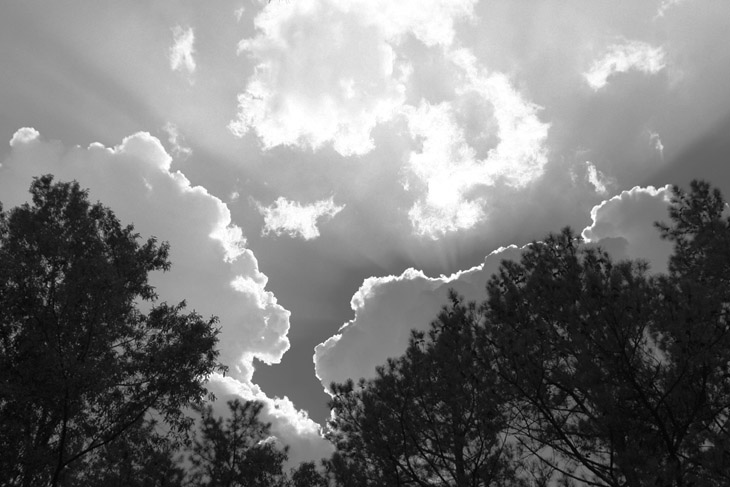
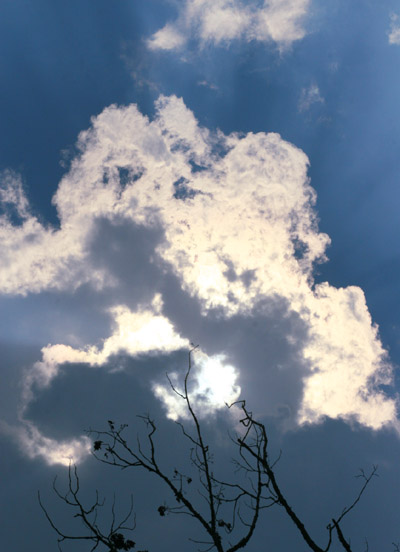 Yes, it’s still been a slow couple of weeks, and I’ve been working on some other projects, so the photography is leaner. Hopefully this is not yet the start of the downward trend that autumn brings.
Yes, it’s still been a slow couple of weeks, and I’ve been working on some other projects, so the photography is leaner. Hopefully this is not yet the start of the downward trend that autumn brings.
While out at the nearby pond yesterday, distant rumbles and the evidence of some towering thunderheads carried the threat of a storm, but it failed to actually hit here so I took advantage of the dramatic cloud formations to do a little sky photography. At top, the sun peering past the edge of the cumulus clouds provided both a high-contrast composition and some faint crepuscular rays through the humid haze. When I noticed this, it was half-hidden behind the tree canopy that bordered the pond, so I dodged back and forth a bit until I could line up the clouds with a complementary gap in the trees. I played around with the color channels, but in the end simply converted to greyscale and tweaked the contrast just a tad higher. The one at left, though, needed the odd colors produced by the thin edges. There are electrical wires in the bottom of the original frame, cropped out here – I really hate electrical wires.
The weather might still have been the after-effects of Tropical Storm Erika, which brought some much-needed rain several days back and dropped the temperatures a bit. Not too long after those rains, while things were still dripping, I was poking around and spotted a tiny crab spider lurking in the blossom of a buttonbush (Cephalanthus occidentalis) – the pollinators that I usually see raiding these flowers are many times the size of this spider, so I suspect it was either enthusiastically optimistic or simply biding its time until the right-sized meal came along.
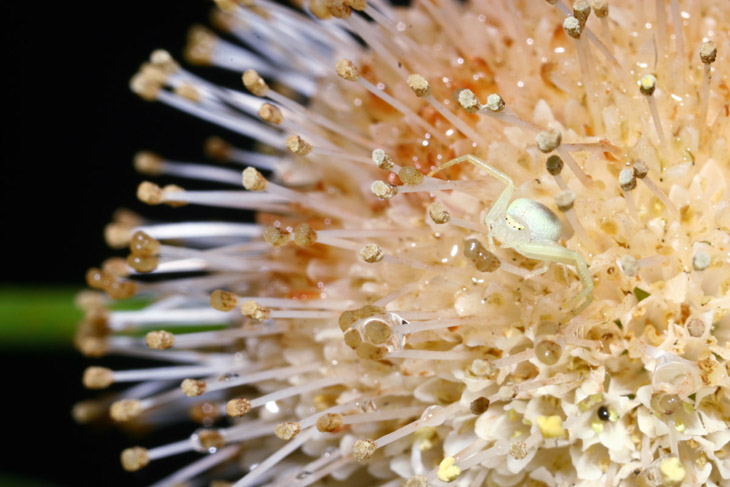
The adhering drops that can be seen with a close examination may give some indication of size, but another shot may help, especially when I tell you that the blossoms are typically the size of a golf ball, and frequented by bumblebees and swallowtail butterflies. This spider, legs spread as wide as it could reach, couldn’t even span the eyes of a bumblebee, so, yeah…
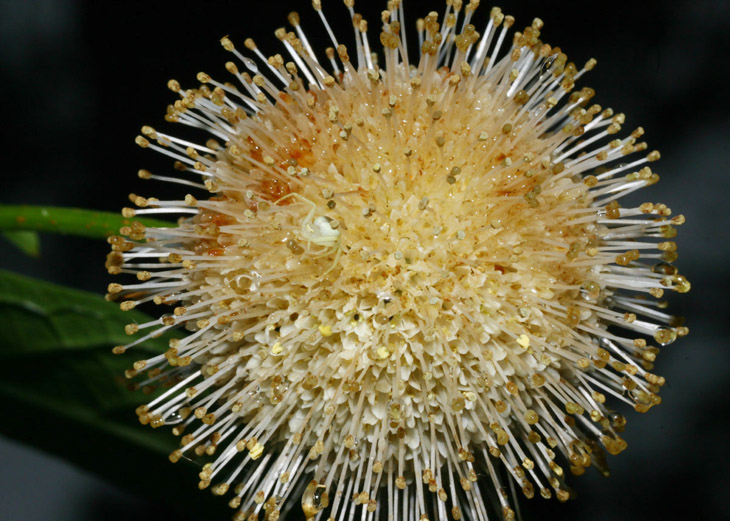
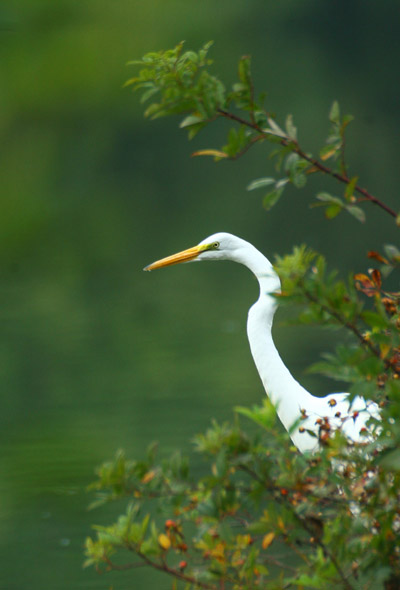 The storm may also have been responsible for the presence of a great egret (Ardea alba) at the pond these past few days, having been driven out of its normal range by the winds. I was used to seeing them in Florida all over, and along the NC coast, but haven’t seen one in this area in a long time. I’m not sure what the resident great blue heron thinks about this newcomer – it’s been the sole big wader for the entire pond, though I have spotted smaller ones for only a day or so – but the pond is big enough to support them both, and the green herons and others. We’ll just have to see if this one decides to stick around. It seems less wary than the great blue – this image was acquired with some very basic stalking – so if it remains for a bit, I might be able to do a more rounded gallery of images.
The storm may also have been responsible for the presence of a great egret (Ardea alba) at the pond these past few days, having been driven out of its normal range by the winds. I was used to seeing them in Florida all over, and along the NC coast, but haven’t seen one in this area in a long time. I’m not sure what the resident great blue heron thinks about this newcomer – it’s been the sole big wader for the entire pond, though I have spotted smaller ones for only a day or so – but the pond is big enough to support them both, and the green herons and others. We’ll just have to see if this one decides to stick around. It seems less wary than the great blue – this image was acquired with some very basic stalking – so if it remains for a bit, I might be able to do a more rounded gallery of images.
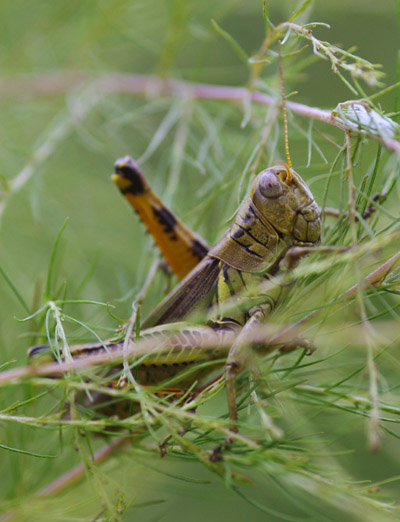 I can’t say if the storms had the slightest to do with these, all I can say is that abruptly, several individuals of this unidentified grasshopper could be found with little effort, when I have been seeing virtually nothing of the sort in the area before. These are big enough to be called ‘locusts,’ better than 5cm in overall body length, and while capable of doing a lot of plant damage, I suspect they won’t last long against the large number of birds and the nearby black-and-yellow argiopes (which have been chowing down on dragonflies and cicadas, and would probably relish the change of diet.)
I can’t say if the storms had the slightest to do with these, all I can say is that abruptly, several individuals of this unidentified grasshopper could be found with little effort, when I have been seeing virtually nothing of the sort in the area before. These are big enough to be called ‘locusts,’ better than 5cm in overall body length, and while capable of doing a lot of plant damage, I suspect they won’t last long against the large number of birds and the nearby black-and-yellow argiopes (which have been chowing down on dragonflies and cicadas, and would probably relish the change of diet.)
 I close with another crab spider, even smaller than the previous, remaining inconspicuous on the underside of a delicate white flower – I haven’t pinned this down for sure, but the flowering vine might be virgin’s bower (Clematis virginiana.) I’m going to have to confirm this because it produces a lot of flowers that we could use around the yard, and thus attract more insects and perhaps hummingbirds. Granted, bigger flowers are more likely to attract the kind of spiders I’d really like to see, but this would be a start, anyway.
I close with another crab spider, even smaller than the previous, remaining inconspicuous on the underside of a delicate white flower – I haven’t pinned this down for sure, but the flowering vine might be virgin’s bower (Clematis virginiana.) I’m going to have to confirm this because it produces a lot of flowers that we could use around the yard, and thus attract more insects and perhaps hummingbirds. Granted, bigger flowers are more likely to attract the kind of spiders I’d really like to see, but this would be a start, anyway.



















































